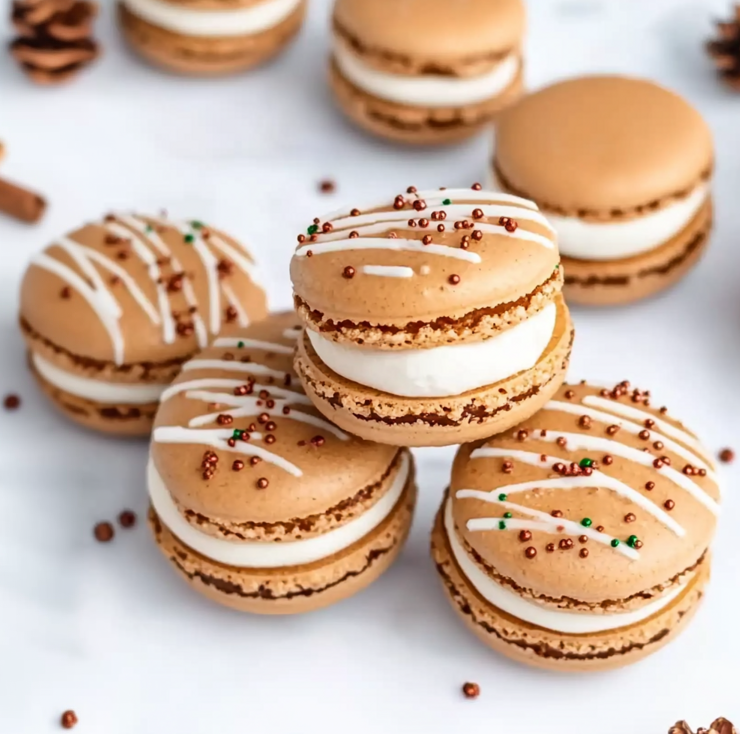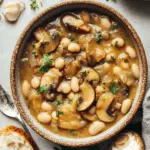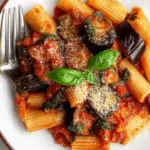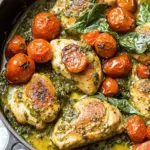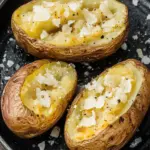These Gingerbread Macarons are a delightful holiday treat, featuring crisp almond shells filled with a rich buttercream infused with molasses and ground ginger. Topped with a festive royal icing drizzle and colorful sprinkles, they capture the warm, spiced flavors of the season. Perfect for Christmas gatherings or as edible gifts, these macarons bring a touch of elegance and cheer to any occasion.
Full Recipe:
Ingredients
Macaron Shells:
- Almond flour
- Powdered sugar
- Egg whites
- Granulated sugar
Gingerbread Buttercream Filling:
- Salted butter (softened)
- Powdered sugar
- Molasses
- Ground ginger
- Heavy whipping cream
Royal Icing Decoration:
- Meringue powder
- Powdered sugar
- Water
- Green and red sprinkles
Directions
- Prepare Dry Ingredients: Sift almond flour and powdered sugar together to ensure a smooth batter.
- Make the Meringue: Whisk egg whites and granulated sugar until stiff peaks form.
- Combine Ingredients: Gently fold the dry mixture into the meringue until the batter flows smoothly off the spatula.
- Pipe and Rest: Pipe the batter onto a baking sheet lined with parchment paper or a silicone mat. Let the shells rest until they are no longer sticky to the touch.
- Bake: Bake at 305°F (152°C) for 14-16 minutes.
- Prepare Buttercream: Beat softened butter until creamy. Add powdered sugar, molasses, ground ginger, and heavy whipping cream. Mix until smooth.
- Decorate Shells: Prepare royal icing by mixing meringue powder, powdered sugar, and water. Drizzle over cooled macaron shells and add sprinkles.
- Assemble Macarons: Pipe buttercream onto one shell and sandwich with another.
- Mature Macarons: Refrigerate assembled macarons for at least 24 hours to allow flavors to meld and achieve the desired texture.
Nutrients
Estimated per macaron:
- Calories: 110 kcal
- Total Fat: 6g
- Saturated Fat: 3g
- Cholesterol: 15mg
- Sodium: 20mg
- Total Carbohydrates: 12g
- Sugars: 10g
- Protein: 2g
The Origins and Popularity of Macarons
Macarons have a rich history dating back centuries, with roots in Italian and French baking traditions. Unlike traditional cookies, French macarons are made with almond flour, egg whites, and sugar, resulting in a smooth, shiny shell with a chewy interior. The delicate nature and vibrant colors have made them a staple in patisseries worldwide. Over time, bakers have experimented with various fillings and flavor profiles, leading to creative adaptations such as the gingerbread macaron, which marries the classic texture with a beloved seasonal flavor.
Why Gingerbread? The Flavor Profile
Gingerbread is synonymous with holiday warmth and nostalgia, characterized by a blend of spices including ginger, cinnamon, cloves, and nutmeg. When incorporated into macarons, these spices complement the subtle nuttiness of the almond shell, creating a harmonious flavor balance. The addition of molasses in the buttercream adds depth and sweetness, evoking the traditional gingerbread cookie taste without overpowering the delicate macaron shell. This fusion highlights the versatility of macarons as a canvas for seasonal and cultural flavors.
The Art and Science of Making Macarons
Creating perfect macarons is often regarded as both an art and a science due to their precise requirements in mixing, folding, and baking. The texture of the shells is influenced by factors such as humidity, temperature, and ingredient quality. The meringue base must be whipped to the right stiffness, and the almond flour must be finely ground and sifted to prevent lumps. The folding technique, known as “macaronage,” requires skill to achieve the ideal batter consistency that flows like lava but holds its shape when piped.
Resting the piped batter before baking is crucial, allowing a skin to form on the shells, which helps develop the signature “feet” – the ruffled edge at the base of the macaron. Baking at a controlled temperature ensures even cooking and prevents cracking or hollow shells. These technical elements combine to produce the elegant and delicate structure characteristic of macarons.
Gingerbread Buttercream: A Perfect Filling
The buttercream filling in gingerbread macarons is a critical component that delivers flavor and moisture. Made with softened butter, powdered sugar, molasses, and ground ginger, this filling offers a creamy contrast to the crisp shells. The molasses adds a rich, slightly smoky sweetness, while the ground ginger provides warmth and spice. Heavy cream is often incorporated to lighten the texture, resulting in a smooth and luscious buttercream that pairs beautifully with the almond shells.
Buttercream fillings are favored for their stability and richness, making them ideal for sandwiching macarons. They hold their shape well and mature the macaron over time, enhancing the melding of flavors. The gingerbread buttercream ensures that each bite is balanced with the perfect blend of sweet, spicy, and buttery notes.
Decorative Elements and Presentation
The visual appeal of gingerbread macarons is enhanced by festive decorations. A drizzle of royal icing on top, often piped in delicate patterns, adds a touch of elegance and holiday cheer. The icing is typically made from meringue powder, powdered sugar, and water, creating a glossy finish that hardens once set. Adding green and red sprinkles gives the macarons a playful and festive look, making them instantly recognizable as a holiday treat.
Presentation plays a significant role in the enjoyment of macarons. These dainty pastries are often served in decorative boxes or trays, making them perfect for gifting or party platters. Their vibrant colors and refined appearance make them a centerpiece for holiday tables or dessert buffets.
Occasions and Serving Suggestions
Gingerbread macarons are versatile treats that can elevate various occasions beyond just the holiday season. They are ideal for Christmas parties, winter weddings, or as part of a festive afternoon tea spread. Because of their small size and elegant presentation, they serve well as bite-sized desserts for receptions or corporate events.
Pairing gingerbread macarons with complementary beverages enhances the tasting experience. Hot drinks such as spiced chai, mulled wine, or a rich hot chocolate balance the sweetness and spice of the macarons, while coffee or espresso adds a contrasting bitterness that sharpens the flavors. For a more indulgent twist, pairing with dessert wines like a late-harvest Riesling or a fortified wine can highlight the molasses and spice notes.
Health and Nutritional Considerations
While macarons are delicious, they are treats best enjoyed in moderation due to their sugar and fat content. The gingerbread macarons have a moderate calorie count per piece but do contain sugars and fats primarily from the buttercream and almond shells. However, the use of almond flour provides some protein and healthy fats, which distinguish them from many traditional cookies.
For those with dietary restrictions, macarons are naturally gluten-free, making them a good option for people with gluten sensitivities or celiac disease. It’s important to ensure that all ingredients, especially sprinkles or decorations, are also gluten-free to avoid cross-contamination.
Tips for Storing and Shelf Life
Proper storage is essential to maintain the texture and flavor of gingerbread macarons. Because they contain buttercream, they should be refrigerated after assembly to preserve freshness and prevent spoilage. However, they are best served at room temperature, so allowing them to sit out for about 20 minutes before eating enhances their flavor and texture.
Macarons also benefit from a maturation period in the refrigerator, typically 24 hours, which allows the flavors to meld and the texture to become more tender and chewy. When stored correctly in an airtight container, they can last up to 5 days. Freezing macarons is possible but may slightly alter the delicate texture of the shells upon thawing.
Cultural Impact and Modern Trends
The rising popularity of macarons globally has sparked creativity among bakers to infuse them with a wide array of cultural flavors and designs. Gingerbread macarons are a prime example of this trend, where traditional holiday flavors meet sophisticated pastry techniques. This blend appeals to a wide audience, from classic holiday enthusiasts to contemporary dessert lovers.
Conclusion
Gingerbread macarons offer a delightful twist on a classic French confection by incorporating the rich, warm flavors of gingerbread into the delicate almond shell and creamy buttercream filling. Their festive appearance and complex flavor profile make them perfect for holiday celebrations and special occasions. Although they require precision and patience to create, the result is a sophisticated and delicious treat that impresses both in taste and presentation.

